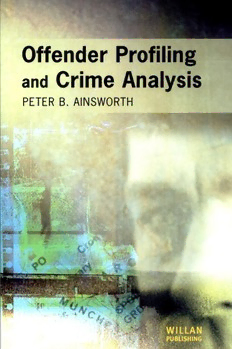
Offender profiling and crime analysis PDF
Preview Offender profiling and crime analysis
Offender Profiling and Crime Analysis Offender Profiling and Crime Analysis Peter B. Ainsworth Published by Willan Publishing Culmcott House Mill Street, Uffculme Cullompton, Devon EX15 3AT, UK Tel: +44(0)1884 840337 Fax: +44(0)1884 840251 e-mail: [email protected] Published simultaneously in the USA and Canada by Willan Publishing c/o ISBS, 5824 N.E. Hassalo St, Portland, Oregon 97213-3644, USA Tel: +001(0)503 287 3093 Fax: +001(0)503 280 8832 © Peter B. Ainsworth 2001 The right of Peter B. Ainsworth to be identified as author of this Work has been asserted by him in accordance with the Copyright, Designs and Patents Act of 1988. All rights reserved; no part of this publication may be reproduced, stored in a retrieval; system, or transmitted in any form or by any means, electronic, mechanical, photocopying, recording or otherwise without the prior written permission of the Publishers or a licence permitting copying in the UK issued by the Copyright Licensing Agency Ltd, 90 Tottenham Court Road, London W1P 9HE. First published 2001 ISBN 1-903240-22-0 (cased) ISBN 1-903240-21-2 (paper) British Library Cataloguing-in-Publication Data A catalogue record for this book is available from the British Library. Printed by T J International Ltd, Trecerus Industrial Estate, Padstow, Cornwall, PL28 RW Contents Contents Preface ix Introduction 1 Discerning patterns in criminal activity 2 Plan of this volume 3 1 Offender profiling – separating myth from reality 5 Is there consensus on what constitutes profiling? 7 What does profiling involve? 7 What do ‘profiles’ look like? 9 Can the goals of profiling be identified? 15 Are there different kinds of profiling? 16 What knowledge do profilers need? 16 Concluding comments 17 Further reading 18 2 Criminal behaviour and its motivation 19 Explanations of criminal behaviour 21 Genetic and individual factors 22 Twin studies 27 Family influences 31 Personality theories 33 Social learning theories 35 Concluding comments 37 Further reading 38 3 Environmental influences and patterns of offending 39 The influence of the environment 40 v Offender Profiling and Crime Analysis Defensible space 41 Is the environment entirely deterministic? 43 Modern housing and its possible effects 44 People’s needs and environmental provision 47 Designing environments which might reduce crime levels 48 Situational crime prevention 49 Crime displacement 50 Environmental effects on target selection 51 Is crime ‘normal? 53 Repeat victimisation 54 Concluding comments 57 Further reading 58 4 Problems and pitfalls in the gathering of data 59 The reporting and recording of offences 59 False reporting of ‘crimes’ 63 How can we know how much crime is committed? 63 Police recording of crime 64 Other ways in which biases may be produced 65 Human perception and memory 66 The interviewing of suspects 76 Concluding comments 78 Further reading 81 5 Crime mapping and geographical profiling 82 The geography of crime 83 The Chicago School 84 The importance of place 86 Crime hot spots 88 Combining geographical and temporal information on crime 90 Is such information useful? 91 Problems an d difficulties with geographic profiling 92 Concluding comments 94 Further reading 99 6 Early approaches to profiling 98 The development of the FBI’s first profiling system 99 Other classifications – selfish v unselfish rapists 103 Further classification of rapists 104 What functions might categorisation have? 107 How useful is the FBI’s approach? 109 Concluding comments 114 Further reading 116 vi Contents 7 Investigative psychology and the work of David Canter 117 The psychological underpinnings of Canter’s work 117 Canter’s work on crime locations 127 Concluding comments 131 Further reading 133 8 Clinical and other approaches 134 The Dutch approach to profiling 134 Contributions from forensic psychiatry and clinical psychology 140 The work of Paul Britton 146 Comparing different approaches to profiling 150 Concluding comments 153 Further reading 154 9 Current developments and future prospects 155 Canter’s more recent work 155 Other recent British work 162 Stalking 168 Concluding comments 172 Further reading 173 Conclusions 174 How useful is offender profiling? 175 References 185 Index 195 vii Offender Profiling and Crime Analysis viii Chapter title Preface Offender profiling appears to be a subject which holds considerable fascination for many people. The notion that profilers have the ability to understand and interpret the actions of serious criminals appears to be a recipe which can almost guarantee sales of books or cinema tickets. When I first announced to my non-academic friends that I was writing a book on the subject of profiling there appeared to be a presumption that the book would be a work of fiction in the mould of Thomas Harris’s now famous Silence of the Lambs. Alternatively people asked whether the book might eventually form the basis for a new television series along the lines of Cracker. Despite the temptation to try my hand at the possibly more lucrative market offered by works of fiction I decided that I would write an academic text which attempts to review the current state of knowledge about profiling. This did not prove to be a particularly easy task! As the reader will see from this volume the area is rife with disagreements abo ut what profiling is about and how it should be conducted. Arguments between profilers have raged for many years and show little sign of abating. Many within the profiling movement stick rigidly to a faith in their own system of working and castigate any who dare to disagree with them. The level of animosity between some individuals involved in profiling work is disturbing. Supporters of one ‘camp’ may well suggest that I have been unfair in my treatment of their work whilst at the same time arguing that I have been too kind to the work of others. Needless to say those from another ‘camp’ may well take the opposite view. ix
